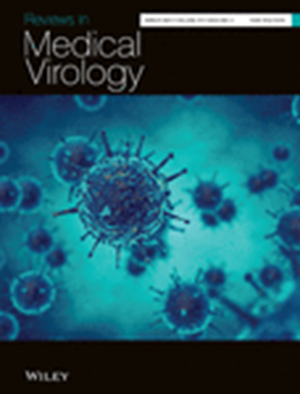揭示人类免疫缺陷病毒 1 型在中枢神经系统中的神经入侵、神经传播和神经炎症三重作用
IF 9
2区 医学
Q1 VIROLOGY
引用次数: 0
摘要
自 1983 年发现人类免疫缺陷病毒 1 型(HIV-1)以来,在控制外周血病毒复制和治疗机会性感染方面取得了许多进展。这不仅延长了患者的寿命,还增加了与年龄相关的中枢神经系统(CNS)疾病以及与艾滋病毒相关的神经变性/神经认知障碍和抑郁症(统称为艾滋病毒相关神经认知障碍(HAND))的发病率。HAND 包括一系列不同的临床表现,从无症状神经认知障碍或轻度神经认知障碍等较轻的形式,到严重的 HIV 相关性痴呆(HAD)。虽然通过抗逆转录病毒联合疗法控制病毒复制和抑制血浆病毒载量降低了 HAD 的发病率,但并没有逆转较轻形式的 HAND。本综述旨在描述 HIV-1 侵入中枢神经系统并在其中扩散的机制,这是导致 HAND 的关键因素。综述将介绍艾滋病病毒感染与手足口病之间关系的证据。此外,还将讨论解释神经炎症在 HAND 发病机制中作用的最新发现,以及治疗和控制的前景。本文章由计算机程序翻译,如有差异,请以英文原文为准。
Unravelling the triad of neuroinvasion, neurodissemination, and neuroinflammation of human immunodeficiency virus type 1 in the central nervous system
Since the identification of human immunodeficiency virus type 1 (HIV‐1) in 1983, many improvements have been made to control viral replication in the peripheral blood and to treat opportunistic infections. This has increased life expectancy but also the incidence of age‐related central nervous system (CNS) disorders and HIV‐associated neurodegeneration/neurocognitive impairment and depression collectively referred to as HIV‐associated neurocognitive disorders (HAND). HAND encompasses a spectrum of different clinical presentations ranging from milder forms such as asymptomatic neurocognitive impairment or mild neurocognitive disorder to a severe HIV‐associated dementia (HAD). Although control of viral replication and suppression of plasma viral load with combination antiretroviral therapy has reduced the incidence of HAD, it has not reversed milder forms of HAND. The objective of this review, is to describe the mechanisms by which HIV‐1 invades and disseminates in the CNS, a crucial event leading to HAND. The review will present the evidence that underlies the relationship between HIV infection and HAND. Additionally, recent findings explaining the role of neuroinflammation in the pathogenesis of HAND will be discussed, along with prospects for treatment and control.
求助全文
通过发布文献求助,成功后即可免费获取论文全文。
去求助
来源期刊

Reviews in Medical Virology
医学-病毒学
CiteScore
21.40
自引率
0.90%
发文量
88
期刊介绍:
Reviews in Medical Virology aims to provide articles reviewing conceptual or technological advances in diverse areas of virology. The journal covers topics such as molecular biology, cell biology, replication, pathogenesis, immunology, immunization, epidemiology, diagnosis, treatment of viruses of medical importance, and COVID-19 research. The journal has an Impact Factor of 6.989 for the year 2020.
The readership of the journal includes clinicians, virologists, medical microbiologists, molecular biologists, infectious disease specialists, and immunologists. Reviews in Medical Virology is indexed and abstracted in databases such as CABI, Abstracts in Anthropology, ProQuest, Embase, MEDLINE/PubMed, ProQuest Central K-494, SCOPUS, and Web of Science et,al.
 求助内容:
求助内容: 应助结果提醒方式:
应助结果提醒方式:


